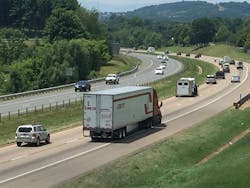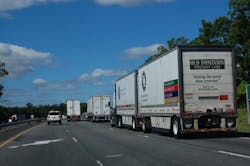So much is happening in the trucking industry right now – the impending imposition of the electronic logging device (ELD) mandate; the push for driverless trucks, even as the need for truck drivers remains acute; the heavily congested and deteriorating state of U.S. highways; the upswing in freight rates – that it’s almost hard to take it all in.
One thing is for certain, though: the frenetic level of activity now being experienced in the freight transport world is only going to keep gaining speed.
So how will all of that impact your particular trucking company?
For starters, Rich Voreis, CEO of Marquette Transportation Finance, offers a few broad-based “30,000-foot view” insights for truckers. To wit:
Regulations will chart a new course for the industry: As with many industries, regulatory oversight can add training time, expenses and processes to everyday operations, Voreis explained. For trucking, on December 18 this year, the compliance phase of the ELD mandate begins as drivers and fleets must start using Federal Motor Carrier Safety Administration (FMSCA) approved ELDs in their vehicles.
“This regulatory change to improve drive time accuracy can be a burden on a company’s operational capital,” he said. “Smaller companies may be unable to absorb the costs of implementing ELDs, while larger companies will have much higher costs associated with compliance. And, no matter the company size, some efficiency will be lost as employees are trained to use the new systems.”
Voreis also believes ELD compliance may decrease cash flow and increase expenses for some motor carriers, while others may leverage this technology “opportunity” to pick up new business.
“As [motor] carriers exit the market, savvy [trucking] companies can pick up the slack which will require flexible financing to support rapid growth, even in an uncertain climate,” he stressed. “In the tightening financial environment, obtaining financing to grow—and quickly—can be a challenge.”
The cost of managing risk is rising: Insurance costs are a given in the transportation industry, said Voreis, yet insurance rates have risen more in transportation than any other commercial market—up 4% in the second quarter of this year after a 5% hike in the first quarter, according to MarketScout.
That increase, compared to only 1% and 2% for other industries, will again impact cash flow and profit margins across the trucking industry, he noted.
The worsening driver shortage: Motor carriers across the nation continue to face a shortage of qualified, reliable drivers to meet freight demand, Voreis said, with inactive trucks still requiring all of the costs of maintenance and insurance without generating offsetting income.
Indeed, as Randy Seals, customer advocate at McLeod Software, noted in a recent panel of driver demographics, based on the current trends lines of freight demand versus driver availability, a potential shortfall of 239,000 drivers may develop by 2022.
Marquette’s Voreis believes three main factors are at work in this shortage: industry growth outpacing driver supply, the need to replace the large percentage of retiring drivers, and the lack of qualified drivers. He added that finding drivers will remain a “top concern” among motor carriers in the coming years.
Mergers and acquisitions will increase: Required regulatory compliance combined with the aforementioned higher costs of risk management and keeping trucks on the road may result in more motor carriers choosing to exit the market, Voreis said. This shift could increase the merger and acquisition opportunities for nimble companies ready to expand their market share. Yet due to all the uncertainties that lay ahead, lenders may offer less financial flexibility.
“If the number of [motor] carriers diminishes, but the remaining businesses are not able to take on the freight volume due to financial restrictions, the industry may see increasing volatility ahead,” he warned.
Traditional financing will become more challenging: All of the above factors are creating more unpredictability in the transportation market, and this last one may have the most pervasive reach, Voreis thinks: Traditional lenders, like banks, have increasingly limited appetite to finance an industry with high cash flow needs and uncertain expenses.
“Fewer traditional banks are willing to lend to transportation companies, and those that do will likely require conservative loan structures with restrictive covenants, and may tighten controls on current loans,” he explained. “Taking advantage of opportunities ahead – such as mergers, acquisitions, and expansion to handle increased business volume – may require freight companies to leverage themselves, other collateral or more receivables beyond many banks’ credit controls.”
All of the above, of course, make things more difficult for truckers. However, in a “glass is half full” take on recent trends, John Larkin – managing director and head of transportation capital markets research for Stifel Capital Markets – noted in a recent presentation to the Iowa Motor Truck Association that other competitive pressures on trucking may be easing.
Take rail intermodal, for example. “People worry about rail intermodal but rail intermodal service, in a word, sucks. And it will suck because the railroads focus on operating ratio as their primary metric; that’s all they care about,” he explained.
Right now, based on rail service data from the time freight leaves the gate at the front of a terminal to the time the intermodal container box is placed on a chassis and ready to be pulled by draymen, on-time performance ranges between 65% and 80%, he said.
“That’s the standard range; often it’s below that,” Larkin added. “If the railroads could ever get their service act together, [intermodal] would be a true play but I don’t see that happening any time soon given the focus on driving [their] operating ratios lower.”
Longer term, though, Larkin said that trucking needs to focus on two other issues that may significantly hinder its efficiency: the deteriorating state of highway infrastructure and whether tractor-trailer specs relied to haul freight need a specification overhaul in light of the rapid growth of e-commerce.
“We have an infrastructure problem in this country; we built the greatest highway system the world has ever seen thanks to the vision of General Eisenhower but we’re not doing a very good job of ‘de-bottlenecking’ that system,” he said.
“We’re not doing a very good job of indexing the income in the Highway Trust Fund to account for inflation. Construction costs inflate just like everything else does and we haven’t taken that into account; we need to fix that somehow,” Larkin added.
“Congress [was] willing to put 20 or so taxes into Obamacare but we don’t want to put one tax or increase in existing tax to take care of something we all need,” he stressed. “[Highways] are an integral part of our logistics supply chain; I think most people would be willing to pay for a highway they use. Toll roads have been very successful in places like Florida [and] Texas.”Then there is the issue of long combination vehicles and moving to twin 33-ft. trailers – a very contentious issue among motor carriers, much less in the public square, where “bigger trucks” and any such related term are anathema.
“The parcel industry and Amazon e-commerce industry would love twin 33s because so much of their freight tends to cube out before it weighs out and 33s which are more stable operationally would really help keep the number of trucks more manageable,” Larkin argued.
Moving to bigger twin trailers could “sort of” help with the driver shortage, too, as beefing up the freight hauling capacity of existing tractor-trailers would decrease the need for more capacity, but Larkin readily admits there is a “fair amount of opposition” to that strategy, especially among traditional 53-ft. trailer-based TL carriers.
“There’s also question as to whether distribution centers, big country plants are set up to load 33s instead of 53s; they’d probably need more loading doors or at least some kind of yard hustling operation which adds expense,” Larkin pointed out.
“Then you have the dolly management, you always have too many dollies in the wrong place at the wrong time just like you have too many [container] chassis in the wrong place at the wrong time in intermodal,” he said.
“I don’t know what’s going to happen with that but it does raise the question if you can’t get twin 33s through Congress how the heck are you going to get autonomous trucks through Congress? Soon at least, I mean it seems like an almost impossible task,” Larkin noted. “Congress can’t agree on whether the sky looked blue or gray today.”
Taken together, Voreis and Larkin offer a lot of interesting trends for trucking to keep tabs on. Whether those trends end up favoring or harming the industry will be the ultimate question in need of answering.



